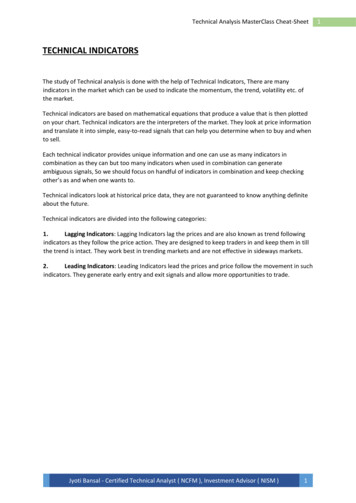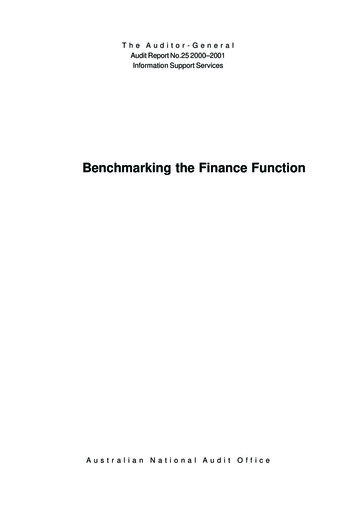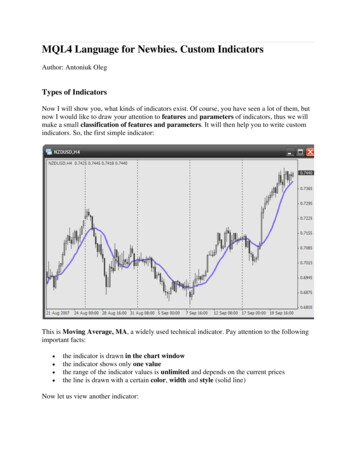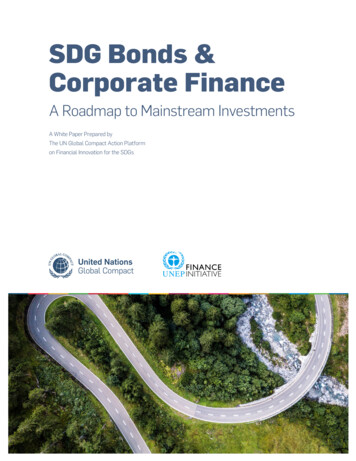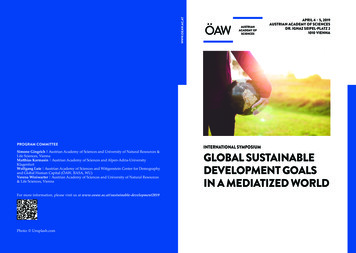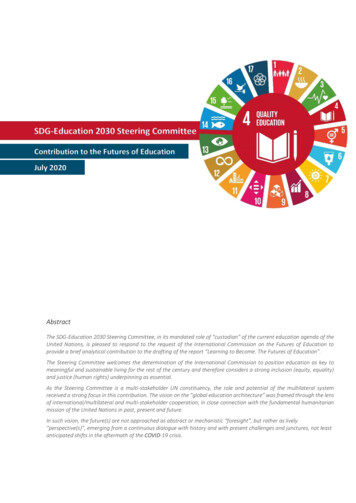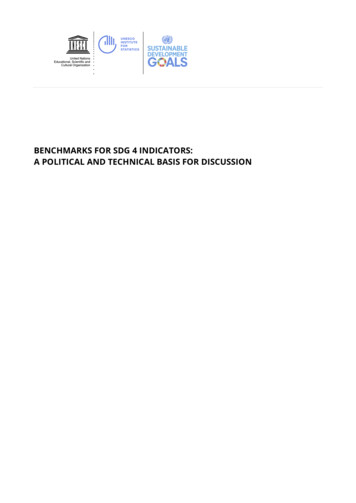
Transcription
BENCHMARKS FOR SDG 4 INDICATORS:A POLITICAL AND TECHNICAL BASIS FOR DISCUSSION
2Table of ContentsIntroduction . 3Political process for setting benchmarks at regional level . 3Technical process for setting regional benchmarks: two approaches . 5Proposed interim national benchmarks . 7Other key methodological issues in setting benchmarks. 9References . 11Annex A. Political process . 12Annex B. Technical alternatives . 14Annex C. Summary benchmark table. 20Annex D. Benchmarking SDG 4 Methodology Annex . 21Country-specific Projections for 2030 . 21Country-specific minimum benchmarks for 2030 . 24Imputation . 25Regional benchmarks . 26List of tables, figures and boxesTable 1. Data availability for proposed benchmark indicators, weighted by school age population. 4Table 2. Regional benchmarking approaches considered . 6Table 3. Approach 1: Regional minimum benchmark for indicator 4.1.1b . 7Table 4. How the proposed interim national benchmarks were defined . 8Box 1. Core concepts used in the proposed benchmark approaches. 8Table 5. Additional methodological points on choice of benchmarks . 10Table A.1. Regions and regional organizations . 12Table A.2. Regional organizations’ education agendas . 13Table B.1. Comparison of benchmark values for indicator 4.1.1 (end of primary, reading) . 14Table B.2. Regional benchmarks for SDG indicator 4.1.1 - Reading at the end of primary . 15Table B.3. Regional benchmarks for SDG indicator 4.1.2- End of Primary . 16Table B.4. Regional benchmarks for SDG indicator 4.1.4 OOSCI End LS . 17Table B.5. Regional benchmarks for SDG indicators 4.2.2 and 4.c.1 lower-secondary . 18Table B.6. Regional benchmarks for public expenditure indicators . 19Figure D.1. SDG 4.1.1 (lower secondary, reading) historical indicator progress and level by country. 22Figure D.2. Albania's historical level and projected levels for SDG 4.1.1 (lower-secondary reading). 23Figure D.3. SDG 4.1.1 (lower secondary, reading) historical indicator progress and level by country. 25Figure D.4. Baseline value and log GDP per capita (SDG 4.1.1 secondary reading). 26Table D.1. Methodology specific to each indicator. 27
3IntroductionThe Education 2030 Framework for Action had called on countries to establish “appropriate intermediatebenchmarks (e.g. for 2020 and 2025)” for the SDG indicators, seeing them as “indispensable for addressingthe accountability deficit associated with longer-term targets” (§28), a request that remains unrealized.The extraordinary session Global Education Meeting in October 2020 reminded countries of thiscommitment. Its Declaration called on “UNESCO and its partners, together with the SDG-Education 2030Steering Committee, to accelerate the progress and propose relevant and realistic benchmarks of key SDG 4indicators for subsequent monitoring” (§10).Fulfilling this neglected commitment to set benchmarks would help renew emphasis on achieving SDG 4.Countries have started from different points and move at different speeds. Unless there is a clearer andshared understanding of where countries started from in 2015, what minimum levels they should achieveand how fast, there is a risk that lack of progress will go unnoticed. But to be effective, benchmarks mustbe designed to mobilize action and communicated in a transparent and informative way.The effectiveness of the process to set, monitor and act on benchmarks rests on two factors: First, political commitment is needed. Setting benchmarks as requested by the Framework forAction cannot be done at global level, given the very large differences in starting points betweencountries. Benchmarks need to be feasible and based on national ownership. A global processmay undermine these objectives. It is therefore proposed to define benchmarks at regional level.Countries within each region tend to have more challenges in common and more opportunitiesto enter into policy dialogue and learn from each other. Second, technical challenges of measurement need to be overcome. A set of indicators to benchmarkwas adopted by the Technical Cooperation Group (TCG) in August 2019. The proposal was basedon a review of proposals by TCG members, which concluded that it would be possible to setbenchmarks for 6 of the 43 SDG 4 indicators – plus the Framework for Action expenditureindicators – based on past trends, country coverage, frequency of data and policy relevance(Table 1).The purpose of this document is to present options on addressing these two challenges, political andtechnical, as a basis for discussion at regional and global levels. Annex D (page 21) describes the conceptsand methodology used in detail.Political process for setting benchmarks at regional levelThe starting point for a benchmarking setting process at the regional level should be the utilization ofexisting regional coordination mechanisms and the involvement of regional organizations with aneducation agenda. While UNESCO mobilizes its SDG 4 regional coordination mechanisms, the activeparticipation of regional organizations is a necessary step for national ownership and essential to achievealignment between global and regional education agendas and to avoid duplication.Annex A presents definitions of regions used in SDG reporting and by the UN Statistical Division,mapping of corresponding regional and sub-regional organizations with an education agenda, andincludes information on those agendas and whether there are systematic efforts to monitor the resultsof their implementation.
4Table 1. Data availability for proposed benchmark indicators, weighted by school age ntlast 5years1. Global indicator 4.1.1Minimum learningproficiency in reading andmathematicsAfrica(Northern) andAsia (Western)DatapointTrendlast 5yearsTrendDatapointlast 5yearsTrend46%3%31%0%2%2. Global indicator 4.1.2Completion rate87%82%88%84%3. Thematic indicator 4.1.4Out-of-school rate62%39%54%4. Global indicator 4.2.2Participation rate one yearbefore primary45%43%53%5. Global indicator 4.c.1Percentage of trainedteachers6. Education 2030benchmarksEducation expenditure asshare of budget and GDP7. Global indicator 4.5.1[Equity indicator]Asia (Centraland Southern)Asia (Easternand Southeastern)DatapointTrendlast 5yearsDatapointlast 69%68%51%54%49%50%72%67%77%77%.OceaniaLatin Americaand theCaribbeanDatapointTrendlast 5yearsNorthernAmerica andEuropeDatapointTrendlast 5yearsDatapointlast %32%30%96%96%89%89%96%56%.
5The TCG under the leadership of the UIS has begun and will continue consultations with UNESCO’sregional coordination mechanisms and with regional organizations to communicate the decisions madein 2019 and to discuss possible next steps towards endorsement of benchmarks in the respectiveregions. As part of the process, a (sub-)regional organization will need to: confirm that it is willing to support a benchmarking process among its member states (withwhatever adaptations they feel are needed) coordinate with other organizations where memberships overlap identify a timeline of consultation and other steps that will lead to benchmarks being approved communicate these steps to the TCG to develop a global roadmap request technical support, where necessary, to facilitate a regional benchmarking processIt is important to stress the following two aspects of flexibility in the proposed process: The definition of region is flexible. Any (sub-) regional organization that expresses an interest tolead the process of defining benchmarks for its member states may do so as long as itcoordinates the process with other organizations with which it has members in common. Setting benchmarks for seven global indicators is consistent with the possibility that a regionalorganization may wish to set additional benchmarks for other indicators that are key to theiragenda.Technical process for setting regional benchmarks: two approachesThe setting of SDG 4 indicator benchmarks will serve three objectives: Availability: identify data gaps that prevent monitoring progress on key SDG 4 indicators; Accountability: assess progress relative to feasible, historically observed trends; and Actionability: lead to data collection and policy responses to fill gaps and accelerate progress.Selecting a benchmarking method to achieve these objectives will be based on the following FERSTprinciples: Fairness: Countries accept the value of benchmarks and that their values are set in a fair waytaking SDG 4 aspirations, their initial conditions and feasible past progress into account. Efficiency: The data that need to support the benchmarks are available for the largest possiblenumber of countries, on a regular basis and in a timely way. Relevance: The indicators are selected to correspond to national and regional agendas and theassessment of whether the benchmark has been met can be linked to policy responses. Simplicity: Benchmarks need to be understood by all countries, while striking a balance betweenthe three objectives outlined above. Transparency: The process by which benchmarks were developed needs to be verifiable and, tothe extent possible, systematic, while it needs to be communicated clearly.The selection of the seven indicators largely meets the principles of efficiency and relevance. Thisdocument addresses two main ways to select benchmarks for the first five indicators (i.e. all except thoserelated to financing and equity) to meet the principles of fairness, simplicity and transparency (Table 2).
6The first approach is suitable for regions or sub-regions that are relatively homogeneous. A common,regional minimum benchmark is set as a minimum that all countries should achieve by 2030. Differentways can be used to set the minimum. For instance, at the lowest end, the regional benchmark could beequal to the minimum progress the country with the lowest indicator value in the region at baseline canachieve. A more ambitious regional benchmark could be equal to the minimum progress a country withan indicator value, say, at the bottom quarter, third or half of countries in the region can achieve.The second approach assumes that a common regional benchmark is not realistic because countriesdiffer too much even within a region or sub-region. Instead, every country has its own benchmark. Whenall the country-specific benchmarks are added up, an implicit regional target ‘benchmark’ emerges. Insetting their own benchmarks, an important reference point is a country-specific minimumbenchmark which reflects feasible progress observed historically for countries with a similar initial levelof the indicator or starting point. Box 1 provides definitions of the benchmarking terms used in thisdocument.Table 2. Regional benchmarking approaches consideredDescriptionApproach 1: Common regional minimum benchmarkfor all countriesEach country in a region has the same benchmark, whichis equal to the feasible progress an indicative country inthe region is expected to make (e.g. the country furthestbehind, the country in the bottom 25% etc.)Approach 2: Different benchmark for each countryEach country sets its own benchmark. One approach isto use country-specific minimum benchmark basedon its initial value and a rate of progress reflecting pastobserved progress (e.g.: the median progress forcountries that have improved since 2000 as appliedbelow).Do all countriesin a region havethe samebenchmark?Is thebenchmarkfeasible for allcountries?Does achievingthe minimumbenchmark (orhigher) result inmeaningful*progress?YesDepends on thelevel of thebenchmark:higher impliesless feasibleDepends on thelevel of thebenchmark:higher impliesmore progressYesYes, but forcountries withslow progresshistoricallyNo* ‘Meaningful progress’ compares the projected value for the region if countries achieve the minimum benchmarkor their projected value (whichever one is higher) to the projection for 2030 in absence of the benchmark.Despite the fact that the two approaches differ in this important respect, regions could opt for a variationthat includes both. For instance, under Approach 1, a region or sub-region may opt for a commonbenchmark for all countries. However, this benchmark will be too low for several countries in the region(Table 3). Some of them may therefore select their own more ambitious benchmark.
7Table 3. Approach 1: Regional minimum benchmark for indicator 4.1.1bRegion or country-income groupAfrica (Sub-Saharan)Africa (Northern) and Asia (Western)Asia (Central and Southern)Asia (Eastern and South-eastern)OceaniaLatin America and the CaribbeanEurope and Northern AmericaLow incomeLower middle incomeUpper middle incomeHigh incomeBaseline(2015 2 years)Minimum 56828344767Countriesachievingbenchmark inbaseline246850693670740336384Under Approach 2, countries may accept the country-specific minimum benchmark based on theirinitial value and a target feasible rate of progress or they may reject it and adopt instead a higherbenchmark depending on their national ambitions and priorities. The need for countries to take an activerole in setting their benchmarks is envisaged in the Framework for Action.Proposed interim national benchmarksFor technical assistance in setting national benchmarks, a dataset will be provided three key referencepoints for each indicator: (1) minimum regional benchmarks defined as the average country-specificminimum benchmark for the lowest third of countries in each region, (2) the country-specific minimumbenchmark which is a feasible benchmark for a country based on its latest indicator value and the medianrate of progress for countries with a similar value that improved since 2000, and (3) a country-specificprojection which reflects a country’s own historical progress for the indicator since 2000. These threereference points are intended to provide countries a basis for setting their own national benchmarks.Until countries select their own benchmark for each of the seven indicators, the following interim nationalbenchmarks are proposed following approach 2. The method for assigning interim national benchmarksis to take the highest value of the three reference points provided: (1) the regional minimum benchmark,(2) the country-specific minimum benchmark and (3) the country-specific projection. The followingexample illustrates how the two approaches can yield different benchmarks for a country (Table 4). Country A, B and C are in the same region and have the same regional minimum benchmark(60 percent) for 2030. Countries A and B are projected to exceed the regional benchmark by 2030 at 75 percent and 68percent, respectively. For these countries, the regional minimum benchmark is not ambitious.Because both countries have the same starting point, their country-specific minimumbenchmarks for 2030 are the same. However, Countries A and B differ in projection. Country A was historically a high performer andis expected to achieve 75 percent by 2030 which exceeds its country-specific minimumbenchmarks, while Country B is projected to be below its country-specific minimumbenchmark by 2030. As a result, the proposed national benchmark for Country A is its countryspecific projection given its rapid progress historically.
8 For Country B, the proposed national benchmark is the country-specific minimum benchmarkbecause achieving this level is expected to be feasible for Country B and offers a realistic goal. Finally, for Country C, its country-specific projection for 2030 and country-specific minimumbenchmark is below the regional minimum benchmark; as a result, its proposed nationalbenchmark is the regional minimum benchmark.Table 4. How the proposed interim national benchmarks were definedCountry ACountry BCountry CBaselineRegionalminimumbenchmark for 2030727254Countryspecificprojectionfor 2030Proposednationalbenchmarkfor 2030Nationallysetbenchmark756852757260-Annex B presents results from the application of these approaches. Tables B1-B3 compare howbenchmarks would look like for each region if each approach were applied. Tables B4-B5 present thebenchmarks of Approach 1, for four of the seven indicators, which uses the progress rate of the bottomthird of countries and which is being proposed as a basis for discussion.Box 1. Core concepts used in the proposed benchmark approachesCountry-specific projection for 2030 1: This is the value that a country is expected to achieve by 2030based on its historical trend from 2000 to the latest available year. For most indicators, countries withhigher levels tend to have lower progress, and this is accounted for in the projection model by using thecountry’s progress relative to other countries with the same starting point.Country-specific minimum benchmark for 2030: This is the value that a country could feasibly achieveby 2030 given the progress made by other countries historically with the same starting point. Note thatthat the minimum benchmark for 2030 differs from the country’s projection for 2030: the latter is whatthe country is expected to achieve, while the former is based on what other countries with the same startingpoint have actually achieved.Regional minimum benchmark for 2030: This is the minimum acceptable level that all countries in aregion should achieve. Because many regions have a diverse range of countries with both high and lowperformers, this benchmark may not apply to countries that are expected to or could feasibly achieve ahigher level—in these cases countries are expected to set their own more ambitious benchmarks or usethe feasible national benchmarks. For the examples presented in Annex 2, the minimum regionalbenchmark for 2030 is the average 2 of the country-specific minimum benchmarks for the lowest third ofcountries.1These are described for 2030 but are applicable to any reference year.2A school-aged weighted average was used.
9Nationally set benchmarks for 2030: Countries are expected to set their own national benchmarksreflecting national priorities and goal. The above three reference points are provided to assist in derivingtheir own benchmarks.Proposed interim national benchmark for 2030: This is the highest of (1) the regional minimumbenchmark, (2) country-specific minimum benchmark, or (3) country-specific projection for 2030.Other key methodological issues in setting benchmarksThe following potential methodological issues may be noted: While benchmarks intend to capture feasible progress achievable in a region, the lack of sufficientdata by region means that global progress rates are inevitably applied as the basis forcalculations. For simplicity, feasible progress is defined over levels achieved until 2018 and will not be updatedto capture progress achieved since 2018. Simplicity is also behind the implicit decision to define benchmarks as a level to be achieved atany year between now and 2030, rather than a benchmark trend with values set for every year.With respect to the latter point, while the benchmark is defined as a level, the rate of progress will alsobe monitored. Annex C proposes a dashboard that distinguishes: Whether the benchmark is reached or not is marked by a colour code; lack of data is marked bygrey. Whether the value of the indicator is increasing (fast) or decreases (fast) is marked by arrows.The following issues also need to be considered: Several indicators are available at different education levels (e.g. primary, lower secondary andupper secondary in indicators 4.1.1, 4.1.2, 4.1.4, 4.c.1) or domains (e.g. reading and mathematicsin indicator 4.1.1). Although benchmarks can be set and monitored for all combinations of levelsand domains, one level or domain for each indicator may be selected as the level and domain offocus (Table 5). The baseline year is 2015. The value is defined as the average of 2013 to 2017. The dashboard can be updated and monitored on an annual basis as new information isincorporated. But it may also be desirable to take stock of the benchmarked indicators in 2020,2025 and 2030. Often data will not be available for these years of reference. For instance,indicator 4.1.1 is typically available every 3 to 5 years depending on the frequency of theassessment in which the country is participating. As with the baseline, it is proposed to reportthe latest value in the last 5-year period. Data for some indicators are potentially available from multiple sources. For instance, thecompletion rate and the out-of-school rate may be estimated through administrative datacollected by the UIS survey or through household survey data. For the time being, it is proposedthat a single source is used (Table 6). In the future, methodologies that ensure the efficient useof both sources may be considered.
10 The choice of regional benchmarks and the fact that collectively they may not add up to theachievement of the target does not dilute the commitment of the international community toachieve the targets as spelled out in the Education 2030 Framework for Action.Table 5. Additional methodological points on choice of benchmarksIndicator levels/domains(1)IndicatorGlobal indicator4.1.1Minimum learningproficiency inreading andmathematicsGlobal indicator4.1.2Completion rateThematic indicator4.1.4Out-of-school rateGlobal indicator4.2.2 - Participationrate one yearbefore primaryGlobal indicator4.c.1 - Percentageof trained teachersEducationexpenditure asshare of totalexpenditureEducationexpenditure asshare of GDPLevels3Grades 2/3;end of primary; endof lower secondaryDomains2Reading;mathematics3Primary;lower secondary;upper secondary4Pre-primary;primary;lower secondary;upper secondary1–4Pre-primary;primary;lower secondary;upper secondary11Possiblelevel/domain(2)Baseline estimate(3)Sources(4)Year2015MethodAccording toprotocol forreportingindicatorLowersecondary2015Last valuein 2011-2015–Lowersecondary2015Last valuein 2011-2015––2015Last valuein 2011-2015UISeducationsurvey–Primary2015Last valuein 2011-2015UISeducationsurvey––2015Last valuein 2011-2015UISeducationsurvey––2015Last valuein 2011-2015UISeducationsurveyEnd ofprimary,readingLearningassessmentsHousehold surveysandcensusesUISeducationsurvey
11ReferencesUIS (2019a) SDG 4 indicator benchmarking consultation. Montreal: UNESCO Institute for Statistics.UIS (2019b) Sixth meeting of the Technical Cooperation Group on the Indicators for SDG 4 Education 2030 Postmeeting consultation on indicator development and monitoring. Montreal: UNESCO Institute forStatistics
12Annex A. Political processTable A.1. Regions and regional organizationsSDG regionsAfrica (Sub-Saharan)Africa (Northern)Asia (Western)Asia (Central and Southern)Asia (Eastern and Southeastern)OceaniaUNSD regionsAfricaSub-Saharan AfricaEastern AfricaMiddle AfricaSouthern AfricaWestern AfricaNorthern AfricaAsiaWestern AsiaCentral AsiaSouthern AsiaRegional organizationsAUSouth-eastern AsiaASEAN SEAMEOEastern AsiaOECDPIF SPC Forum EducationMinisters (FEM)OECDOceaniaAustralia and New ZealandMelanesiaMicronesiaPolynesiaAmericasLatin America and theCaribbeanNorthern AmericaEuropeEAC IGADECCASSADCECOWASALECSOALECSOSAARCOASLatin America and the CaribbeanOEICaribbeanCentral AmericaSouth AmericaNorthern AmericaEuropeEastern EuropeNorthern EuropeSouthern EuropeWestern EuropeCARICOM OECSCECCMERCOSUR ANDEANSPC OECDCOE EU OECD
13Table A.2. Regional organizations’ education agendasEducation agenda s /benchmarksContinental EducationStrategy for Africa 20162025YesNoNo––––Work Plan on Education2016-2020Education Agenda 2035NoYesNoNoNoNoSAARC Development GoalsIn processNoNoEducation QualityAssessment ProgrammeYesYesNoHuman ResourceDevelopment 2030 StrategyCentral America EducationProgramme (PEC)OECS Education SectorStrategyYesYesNoYesYesNoYesYesNoOperational ProgrammeEducation and Training2020NoYesNoYesNoYes–YesYesNoSub-Saharan AfricaAfrican Union (AU)Northern Africa/Western AsiaArab League Educational Culturaland Scientific Organization(ALECSO)Asia/PacificAssociation of Southeast AsianNations (ASEAN)Southeast Asian Ministers ofEducation Organization (SEAMEO)South Asian Association forRegional Cooperation (SAARC)SPC Pacific CommunityForum Education MinistersLatin America/CaribbeanCaribbean Community (CARICOM)Central American Educational andCultural Corporation (CECC)Organization of Eastern CaribbeanStates (OECS)Europe and Northern AmericaCouncil of Europe (COE)European Union (EU)OtherOrganization for Economic Cooperation and Development(OECD)
14Annex B. Technical alternativesTable B.1. Comparison of benchmark values for indicator 4.1.1 (end of primary, reading)BaselineRegionalAverageValue 2015( /- 2 years)RegionalMinimumBenchmark(Approach 1)Projected regionalaverage (if nobenchmarks areachieved – business asusual)SDG: Africa (Northern) and Asia (Western)645865SDG: Africa (Sub-Saharan)272138SDG: Asia (Central and Southern)463850SDG: Asia (Eastern and South-eastern)726076SDG: Europe and Northern America919792SDG: Latin America and the Caribbean504850SDG: Oceania682971WB: conflict-affected situations271836WBG: high income919793WBG: low income101723WBG: lower middle income433449WBG: upper middle income715573RegionProjected regionalaverage if interimnational benchmarksare achieved(Approach 2)SDG Regions74485784986576WB Regions4598325783Notes: Under Approach 1, the benchmark is equal to the average of the country-specific minimum benchmarks for the bottom third of countries in theregion. Note that the average is a school-age population weighted. Under Approach 2, the regional values are not a regional benchmark per se but the regional average of the interim national benchmarks; thisoffers a goal for the region to achieve.
15Table B.2. Regional benchmarks for SDG indicator 4.1.1 - Reading at the end of primaryRegionAveragebaselinevalue2015 2yearsRegionalMinimumbenchmark 2030Average of interimnationalbenchmarks 2025Average of interimnationalbenchmarks 2030(Approach 1)(Approach 2)(Approach 2)SDG RegionsSDG: Africa (Northern) and Asia (Western)63.758.47174SDG: Africa (Sub-Saharan)27.221.04448SDG: Asia (Central and Southern)46.338.05357SDG: Asia (Eastern and South-eastern)72.360.18084SDG: Europe and Northern America91.297.39798SDG: Latin America and the Caribbean50.347.66165SDG: Oceania67.528.77476WB: conflict-affected situations26.917.84145WBG: high income91.297.19898WBG: low income10.517.42832WBG: lower middle income43.433.55357WBG: upper middle income71.155.27983WB Regions* The average baseline is weighted by the total school age population in each country.* Average of countries’ interim national benchmarks for 2025 and 2030 is the regional average if the interim national benchmarks are achieved.
16Table B.3. Regional benchmarks for SDG indicator 4.1.2- End of PrimaryRegionAveragebaseline value2015 2 yearsRegionalminimumbenchmark2030(Approach 1)Average of interimnationalbenchmarks 2025Average of interimnationalbenchmarks 2030(Approach 2)(Approach 2)SDG RegionsSDG: Africa (Northern) and Asia (Western)88989496SDG: Africa (Sub-Saharan)65648186SDG: Asia (Central and Southern)89869597SDG: Asia (Eastern and South-eastern)96989999SDG: Europe and Northern America99100100100SDG: Latin America and the Caribbean93989798SDG: Oceania89849092WB: conflict-affec
A set of indicators to benchmark was adopted by the Technical Cooperation Group (TCG) in August 2019. The proposal was based on a review of proposals by TCG members, which concluded that it would be possible to set benchmarks for 6 of the 43 SDG 4 indica

